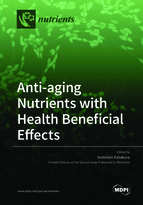Anti-aging Nutrients with Health Beneficial Effects
A special issue of Nutrients (ISSN 2072-6643). This special issue belongs to the section "Nutrition and Public Health".
Deadline for manuscript submissions: closed (15 November 2021) | Viewed by 48407
Special Issue Editor
Interests: anti-aging; functional foods; sirtuin; brain foods; polyphenol
Special Issues, Collections and Topics in MDPI journals
Special Issue Information
Dear Colleagues,
Recently, many kinds of foods and food-derived nutrients have been reported to show health-beneficial effects. In particular, some foods and food-derived nutrients have shown anti-aging effects on several organs and tissues, such as brain, muscle, skin, intestine, and so on. In some kinds of foods, the molecular basis of their functionalities (e.g., anti-brain aging, anti-sarcopenia, and anti-skin aging) and inter-tissue networks activated by these foods mediated by exosomes, cytokines, and immune cells have been clarified in detail. The aim of this Special Issue is to bring together recent research on these topics. Studies about the anti-aging ability of foods and food-derived nutrients and their molecular aspects will be considered. Manuscripts that demonstrate functionalities in vivo as well as in vitro of anti-aging foods focusing upon nutrients are also welcome.
Prof. Dr. Yoshinori Katakura
Guest Editor
Manuscript Submission Information
Manuscripts should be submitted online at www.mdpi.com by registering and logging in to this website. Once you are registered, click here to go to the submission form. Manuscripts can be submitted until the deadline. All submissions that pass pre-check are peer-reviewed. Accepted papers will be published continuously in the journal (as soon as accepted) and will be listed together on the special issue website. Research articles, review articles as well as short communications are invited. For planned papers, a title and short abstract (about 100 words) can be sent to the Editorial Office for announcement on this website.
Submitted manuscripts should not have been published previously, nor be under consideration for publication elsewhere (except conference proceedings papers). All manuscripts are thoroughly refereed through a single-blind peer-review process. A guide for authors and other relevant information for submission of manuscripts is available on the Instructions for Authors page. Nutrients is an international peer-reviewed open access semimonthly journal published by MDPI.
Please visit the Instructions for Authors page before submitting a manuscript. The Article Processing Charge (APC) for publication in this open access journal is 2900 CHF (Swiss Francs). Submitted papers should be well formatted and use good English. Authors may use MDPI's English editing service prior to publication or during author revisions.
Keywords
- anti-aging
- nutrients
- polyphenol
- functional food
- ant-aging signal







